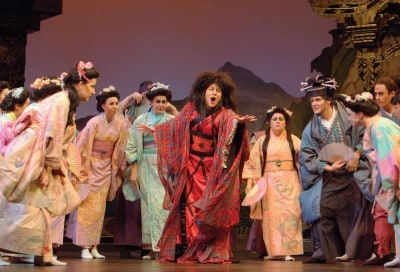The Mikado
Location: Lamplighters Music Theatre
- Conductor: Monroe Kanouse<br/>
- Director: Jane Erwin Hammett
- Aug. 11th and 12th at Mountain View Center for the Performing Arts<br/>
- Aug. 25th and 26th at Bankhead Theater in Livermore
Culturally, we’ve moved past the ironical ’90s, in which every statement was so heavily laden with double and triple meanings that it dead-ended. Perhaps such cultural nihilism couldn’t survive in a post-9/11 world. Perhaps we’ve left the null value statements for our politicians. Perhaps, it all just got to be too much. That said, this shift, however, welcome it may be, raises the question where a culture goes after it’s exhausted its irony. Someone recently pointed out that you just can’t go back to a pre-ironical world. This question is meaningful to all the arts today.
Such questions seem beside the point, when it comes to the Lamplighters’ production of The Mikado. How could irony possibly exist in the land of Titipu, peopled as it is with characters named Yum Yum, Pish-Tush, Pooh Bah, Nanki-Poo, and other appellations that don’t qualify as pseudo-Japanese – and probably didn’t even back in 1885 when it first opened?
One wonders where this opera first came from, with its unlikely cast of characters, and downright silly plot. Most authorities agree that Gilbert and Sullivan were poking fun at British authorities by staging them as Japanese characters. Assuming this is true, the references were so subtle that they went straight past Queen Victoria, who attended a special 1891 performance at Balmoral. Alternatively, Gilbert and Sullvan could have been responding to the Japonisme, (alternatively, Japonism) that so influenced European artists of the time.
Regardless where it came from, the Mikado that landed in the Mountain View Performing Arts Center made for a very un-ironical, positively rollicking night out. This production was brilliantly cast, with Robby Stafford as the unctuous and officious Pooh Bah, Moira McManus as the delicious Yum Yum, and F. Lawrence Ewing as Ko-Ko, and John Melis as Pish-Tush. The very first triple drum beat in the overture signaled you were in for an evening of downright silliness, albeit in top operatic form. Their “I have a little list,” followed Eric Idle and the English National Opera’s lead, and took on everything and everyone from talking heads and texting drivers to Sarah Palin. This was done while maintaining the authenticity that the Lamplighters are known for.

The only off bits were the costuming of the female ensemble, who wore faded matte cotton kimonos that could have benefited from a pressing, and dear Pooh Bah’s frightful wig, a mish-mosh of latex bald spots and pigtails. These were minor details, compared to the stunning vocals, and virtuoso orchestra under the baton of Monroe Kanouse.
While far from an answer to the “where do we go?” question that I started this review with, the Lamplighters’ performance suggests that such answers exist. Casting an eye back while writing for the future with sensitivity and humor, may be one direction out of the cultural crossroads we find ourselves in.




